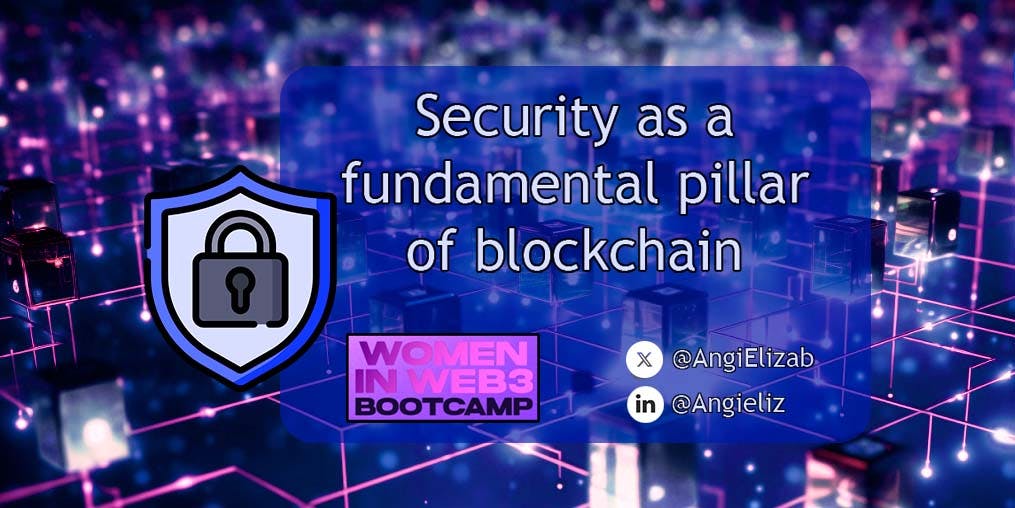Web 3 promises to be the future of the internet, built on the pillars of decentralization, automation, interoperability, and security. This world, which includes artificial intelligence, the metaverse, and decentralized finance, is powered by blockchain technology. Blockchain not only allows for decentralization but also protects our data and gives us, the users, greater control over it.
In this essay, we will explore this technology in depth and what makes it secure.
Review: How does blockchain work?
Imagine a giant registry shared with people all over the world, where each entry records a transaction (sending money, buying a product, etc.) and no one can delete or modify previous entries. That's blockchain, a decentralized digital ledger.
The information in the blockchain is structured in blocks that are organized according to their temporal sequence and are protected by cryptographic techniques. This ensures the integrity of the data due to its immutable nature, which means that once the information has been registered, it cannot be modified in the past. Each block contains transactions and is connected to the previous one, forming a chain. Decentralization is fundamental, as there is no central authority controlling the transactions or data.
Private and public blockchains
In a public blockchain, anyone can join and remain anonymous, with open access through the internet. Transaction validation is done through bitcoin mining and consensus (which we will explore in the next point) is reached through this process. Examples of this are Bitcoin and Ethereum.
In contrast, private blockchains require identity confirmation for membership and only allow the participation of known organizations. Validation is done through selective endorsement and identity control is stricter.
Feature | Public Blockchain | Private Blockchain |
|---|---|---|
Who can join? | Anyone can join and remain anonymous | Only known organizations can join |
Access | Open access through the internet | Confirmation of identity for membership |
Transaction validation | Through bitcoin mining | Through selective endorsement |
Consensus | Through bitcoin mining | Through selective endorsement |
Identity controls | Few identity and access controls | Requires more identity and access controls |
Privacy | Less privacy due to anonymity | More privacy due to identification |
Decentralization | More decentralization | Less decentralization |
Control | Less control, less suitable for compliance | More control, more suitable for compliance |
What is consensus?
Consensus (in blockchain) refers to how participants in the aforementioned decentralized network reach an agreement on which transactions are valid and how the integrity of the system will be maintained. In a decentralized network, there is no central authority to dictate the rules, so it is essential that all nodes agree on the validity of the transactions.
To achieve this, consensus algorithms are used that establish the rules for validating transactions and creating new blocks in the chain.
Proof of Work (PoW): Miners try to solve complex mathematical problems using "hashing attempts". The more computational power they have, the more attempts they can make per second. This gives them more chances to find a valid solution to add a new block to the chain. PoW ensures that only miners who reach consensus on the network can validate and add a block to the blockchain.
Proof of Stake (PoS): Blocks are validated based on the amount of coins accumulated by the participants, rather than computational power. The validator of each block, known as a forger or minter, is determined based on the investment in the cryptocurrency itself. PoS uses a pseudo-random election process that considers the node's capital and the age of the coins, along with a randomization factor.
Consensus algorithms are vital to ensure the security and integrity of cryptocurrencies by allowing nodes to agree on the correct version of the blockchain.
How secure is blockchain?
The different characteristics of this technology, such as its immutability, cryptography, and decentralization, make us consider it a secure technology.
It clearly offers us many advantages, and while it is a promising technology, we should be aware of its risks.
There are four main risks and tools used by hackers: phishing (attempting to trick you into revealing personal or financial information), routing (manipulating internet traffic to redirect it to fake websites or to intercept data), Sybil (generating multiple fake identities on the network to overload it and compromise its operation), and 51% attacks (if a miner or group has more than 50% of the mining power, they can control and manipulate the ledger).
Web 3 is based on blockchain technology, which aims to revolutionize the internet through decentralization, automation, interoperability, and security. Although this technology offers benefits such as protecting the integrity of data and empowering users, it also faces challenges such as phishing, malicious routing, and Sybil attacks. However, its immutability and cryptography features are designed to counteract these risks and ensure the reliability of the system.
- Loading comments...
